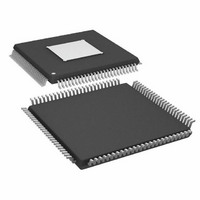ADAU1445YSVZ-3A-RL Analog Devices Inc, ADAU1445YSVZ-3A-RL Datasheet - Page 79

ADAU1445YSVZ-3A-RL
Manufacturer Part Number
ADAU1445YSVZ-3A-RL
Description
175MHZ SigmaDSP,2x8 SRCs
Manufacturer
Analog Devices Inc
Series
SigmaDSP®r
Type
Audio Processorr
Specifications of ADAU1445YSVZ-3A-RL
Applications
Automotive Audio
Mounting Type
Surface Mount
Package / Case
100-TQFP Exposed Pad, 100-eTQFP, 100-HTQFP, 100-VQFP
Format
Fixed Point
Program Memory Size
Not RequiredKB
Operating Supply Voltage (typ)
1.8/3.3V
Operating Temp Range
-40C to 105C
Operating Temperature Classification
Industrial
Mounting
Surface Mount
Pin Count
100
Lead Free Status / RoHS Status
Lead free / RoHS Compliant
Lead Free Status / RoHS Status
Lead free / RoHS Compliant
Available stocks
Company
Part Number
Manufacturer
Quantity
Price
Company:
Part Number:
ADAU1445YSVZ-3A-RL
Manufacturer:
Analog Devices Inc
Quantity:
10 000
SOFTWARE FEATURES
SOFTWARE SAFELOAD
To update parameters in real time while avoiding pop and click
noises on the output, the ADAU1445/ADAU1446 use a software
safeload mechanism. SigmaStudio sets up the necessary code
and parameters automatically for new projects. The safeload code,
along with other initialization code, fills the first 36 locations
in program RAM. The first eight parameter RAM locations
(Address 0x0000 to Address 0x0007) are configured by default
in SigmaStudio as described in Table 78.
Table 78. Software Safeload Parameter RAM Defaults
Address 0x0000, which controls the modulo RAM size, is set by
SigmaStudio and is based on the dynamic address generator
mode of the project.
Address 0x0001 to Address 0x0005 are the five data slots for storing
the safeload data. The safeload parameter space contains five data
slots by default because most standard signal processing algorithms
have five parameters or fewer.
Address 0x0006 is the target address in parameter RAM (with
an offset of −1). This designates the first address to be written.
If more than one word is written, the address increments
automatically for each data-word. The reason for the target
address offset of −1 is that the write address is calculated relative to
the address of the data, which starts at Address 0x0001. Therefore,
if the intention is to update a parameter at Address 0x000A, the
target address should be 0x0009.
Address 0x0007 designates the number of words to be written.
For a biquad filter, the number is five. For a simple monogain
Address
(Hex)
0x0000
0x0001
0x0002
0x0003
0x0004
0x0005
0x0006
0x0007
Function
Modulo RAM size
Safeload Data 1
Safeload Data 2
Safeload Data 3
Safeload Data 4
Safeload Data 5
Safeload target address (offset of −1)
Number of words to write/safeload trigger
Rev. A | Page 79 of 92
cell, the number is one. This address also serves as the trigger;
when it is written, a safeload write is triggered on the next frame.
The safeload mechanism is software based and executes once
per audio frame. Therefore, system designers should take care
when designing the communication protocol. A delay equal to
or greater than the sampling period (the inverse of sampling
frequency) is required between each safeload write. At a sample
rate of 48 kHz, this equates to a delay of greater than or equal to
20.83 μs. If this delay is not observed, the downloaded data will
be corrupted.
SOFTWARE SLEW
When the values of signal processing parameters are changed
abruptly in real time, they sometimes cause pop and click sounds
to appear on the audio outputs. To avoid this, some algorithms
in SigmaStudio implement a software slew functionality. Software
slew algorithms set a target value for the parameter and contin-
uously update the parameter’s value until it reaches the target.
The target value takes an additional space in parameter RAM, and
the current value of the parameter is updated in the nonmodulo
section of data RAM. Assignment of parameters and nonmodulo
data RAM is handled by the SigmaStudio compiler and does not
need to be programmed manually.
Slew parameters can follow several different curves, including an
RC-type curve and a linear curve. These curve types are coded
into each algorithm and cannot be modified by the user.
Because algorithms that use software slew generally require more
RAM than their nonslew equivalents, they should be used only
in situations in which a parameter will change during operation
of the device.
Figure 59 shows an example of a volume slew applied to a sine wave.
INITIAL VALUE
Figure 59. Example of Volume Slew
NEW TARGET
VALUE
ADAU1445/ADAU1446
CURVE
SLEW














